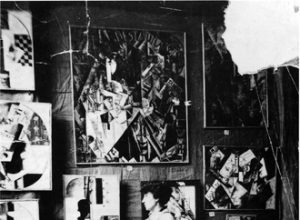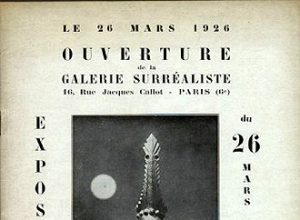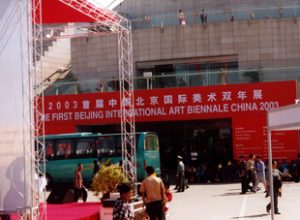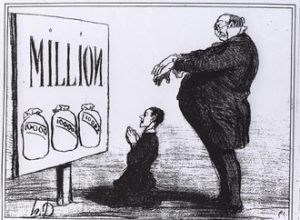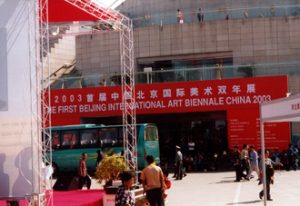
In The Ephemeral Museum, Francis Haskell decried the new hegemony created by major art exhibitions and the harmful consequences thereof. He recalled the genesis of the ways in which art works circulate as well as, from the early twentieth century, the first loans of paintings for prestigious international exhibitions, the establishment of ties between museums and other institutions, and the role played by various forms of nationalism.
Exhibitions have always been sites of legitimation and regulation for artistic life and for the market. The history dates back to the seventeenth century and to the first salons organized by the young Academy of Painters and Sculptors, which tried to curb a movement toward self-management on the part of artists. Thus, toward the middle of the seventeenth century, a certain Martin de Charmois could complain to the royal family about artists who wanted to shake off their status as artisans by keeping shop themselves and securing their own market.
We know what followed, with salons organized by a powerful Academy ultimately coupled with juries that were more open to varied selection criteria. From a still rather simple system affecting a still rather limited and homogeneous world, we have passed over to an ever more complex situation with an ever greater number of actors, sites, and objects for the use of vaster and vaster populations. One need only examine to what extent Biennials have proliferated since the 1990s, establishing themselves now as genuine artistic phenomena in their own right as well as for purposes of tourism and diplomacy and with regard to economic and political considerations.
Paul Ardenne and Olivier Berggruen, who are art historians as well as exhibition curators, have had many years of experience dealing the events that punctuate international artistic life. The assessments they have drawn up are both informed and critical: acceleration, globalization, and standardization of the norms of legitimation as well as of the sites of presentation; cross-fertilization among institutions that have become interchangeable; the preeminent place of art fairs, of show business [du spectacle], and of economics, with elitism and populism combined amid unequal exchanges between the West and its partners.
In this respect, islets of resistance–if not breaches–do indeed exist. But to some, the political condition of art will seem to be determined largely by positions that might aim more at maintaining a bogus exoticism than at inventing a true dialogue with new arrivals on the market. Others will see the extension of the domain of art as a privileged site for tensions wherein questions of identity and power are tirelessly raised over and over again through breaking down existing fiefdoms and by an effort to activate the world’s thought.
Laurence Bertrand Dorléac
Seminar of June 29, 2006

Inauguration of the First Beijing International Art Biennial, 2003.
The main purpose of the present talk is to provide an account of the phenomenon of globalization in the arts. The essential vehicle for this process is the major international art exhibition (Documentas, Manifestas, biennials from the North and the South, and so on). The second point to be broached here concerns the cultural homogenization that results from the way in which these major exhibitions are organized. For, save for some very rare exceptions, the West is always the project director. We shall see that, as a consequence, the international art exhibition can be viewed in two ways: as a generous aesthetic offer that recycles the diversity of forms of artistic expression coming from various places and as an effort at aesthetic regulation benefitting the West.
Large-Scale Art Mediation
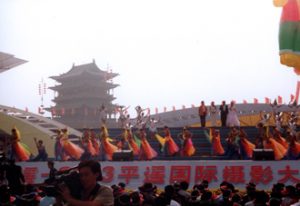
Inauguration of the First Beijing International Art Biennial, 2003.
The first thing to be pointed out–right away and even before proceeding to our argument–is that major contemporary-art exhibitions organized at the international level are not a recent phenomenon. Indeed, the oldest ones date from the late nineteenth century, in concert with the establishment of the first art biennial in history, the Venice Biennale, in 1895. Nor are all of these exhibitions run by institutions. That was the case with the Armory Show, which took place shortly before the outbreak of World War One; French and European avant-garde artists were able to tour North America as part of an initiative that owed its success to a variety of sources, including patrons, dealers, and the artists themselves. And not all exhibitions are alike; that is to say, not all of them are motivated by a desire to exhibit, in its entirety, “art in the process of being made” (which is what contemporary art, in the strict sense, is). Their intention may, on the contrary, be to bring out some particular aesthetic trend or to advance some overtly partisan choice, as with Berlin’s Dada Messe in 1920, the counterexhibition to the Colonial Exhibition of 1931 organized by the Surrealists, the London International Surrealist Exhibition in 1938, Harald Szeemann’s “When Attitudes Become Form” in Berne, in 1969, and so on.
What is patent, once this point is made, is that, while the history of international exhibitions of living art was developing, a growing homogenization of this model for large-scale mediation was also taking place. In what sense is that so? There are: (a) the preponderant role of the Western institutional view, which is supposed to prevail for world art as a whole (despite a few revisions during the 1990s, when there was a flowering of multiculturalism); (b) the limitation of supply, as the phenomenon of “Top Fifty” kinds of lists became more frequent; (c) the increased concentration of so-called “consecrational” major international artistic events (with, as its inevitable consequence, the homogenization of supply, which closely follows upon its concentration), big showcases that can, in the case of contemporary art, be hierarchized as follows: Documenta Kassel in Germany (created in 1955 under the auspices of the American occupation forces as an event that would take place every four years, then every five years); the major continent-wide biennials of contemporary art; and, finally, specific events, like the “Premices” (Beginnings) exhibition run by the French Ministry of Culture in New York in order to present there a section of France’s artistic creativity during the 1990s.
The “Biennialist” Model
How this “consecrational” power of major international art exhibitions is structured can best be understood by taking the example of contemporary-art biennials. During the past twenty years, these kinds of events have really spread all over the place. I shall develop my argument on the basis of the example of biennials, and I shall do so from the perspective of how the mediation of living art–an essentially cultural phenomenon–proves to be inseparable from an evidently political will to make of art, more than a merely aesthetic product, an effective agent of international relations.
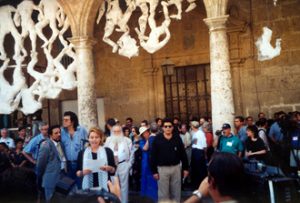
Havana, Seventh Art Biennial. Inauguration on the Plaza Vieja.
Now numbering about forty, contemporary-art biennials today constitute well-established poles of attraction for geocultural tourism. Sometimes showcases for local art, sometimes intermediaries for global trends, they develop along with globalization itself. While a few biennials opt for a regionalist form of resistance, others, still more numerous and stereotypical, endeavor instead to homogenize styles, aesthetic ideas, and critical outlooks. Are biennials mere products of an industrialized culture ? They are, rather, the key vehicle for a kind of standardization, already underway and cross-cultural in spirit, of artistic creation on an international scale.
What is one talking about when one speaks of an art biennial ? What it boils down to is a trade show [salon] set in a certain established site (like the automobile show, the boat show, and so on). Its content is geared toward supplying what is currently available, and “art” is presented there in such a way as to heighten and highlight its value. It is a flexible sort of exhibition, therefore, one that avoids the sclerosis of duplicating the kind of “flexibility” that is today characteristic of our lives, economies, values, and forms. Such adaptability on the part of art biennials explains in large measure the success of this genre, from the pioneering creation of the Venice Biennale (April 30, 1895) and the Whitney Museum Biennial in New York (1932) onward. In the Fifties, one new biennial was created (São Paulo); from the Sixties through to the Eighties, ten (including Havana and Sydney); since 1990, twenty-three.[ref] In a list that is constantly evolving, we have: Cetinie, Lyon, Uppsala, Johannesburg, Shanghai, Taipei, Gwangju, Santa Fe, Puerto Rico, Santo Domingo, Montreal, Liverpool, Manifesta, Berlin, Fortaleza, Prague, Iasi, and so on and so forth. Let us note that a committee was recently formed to reestablish an art biennial in Paris before the end of 2003, the last one dating from 1985. At the time these lines are being written, this committee’s website was, however, not answering its subscribers.[/ref]
A platform for rendering works of art visible, a biennial is, as such, a tool for legitimation. What is highlighted and developed there may favor local art–as in the “national” biennials of the Whitney Museum in New York, for American art, as well as in the “regional” ones, those of Dakar, Cairo, Buenos Aires, Lima, Sharjah (United Arab Emirates), and the Caribbean zone. A biennial may also promote the artistic activity of a broader geographical area, this sometimes being done in the name of Third-World demands, as in the “civilizational” biennials of Havana and Johannesburg. Or, the art of a biennial may be clearly international in scope, with no geographical frame other than that of the whole planet. It is this tendency that has today become dominant and is being fostered by a cut-and-paste approach to exhibiting: Istanbul 2001, for example, recycled numerous mainstream artists shown in Venice a few months earlier.
An Expansionist and Political Aim
Another characteristic of biennials is their irrepressible tendency toward greater and greater expansion, with ever more works, artists, and curators. The first Prague Biennale (June 2003), its ad proclaimed, “announces itself as the major art event of the year, with 30 international curators and about 200 artists from the world over.”[ref]Translator: See http://www.pq.cz/english/accomp.html [/ref] Ever more exhibition spaces, too. In 2002, the Whitney Museum Biennial treated itself to an outdoor section. When it was created, the Lyon Biennial was spread out upon a single site; five editions later, it had spread over five sites. Havana’s, like Istanbul’s, has become fragmented among various buildings that are listed as local heritage sites–a touristy setting if there ever was one. Does such maximalism express a noble desire to improve upon the existing visual supply? It exhibits, rather, a classic strategy of showing off that is carried out in order to achieve the following end: to build up the biennial’s own credibility and to add further to its already added value.
Venice, the oldest of the biennials, offers the perfect model for such a change, to the point of symbolic hyperpower. At the outset, there were national pavilions financed by States desirous of being represented on Venetian territory. Subsequently, the exhibition was enlarged to favor forms of artistic expression that ill fit into these national pavilions–as with the aperto sections, starting in the 1980s. After that, the catchall solution was adopted: a ritualized major thematic exhibition soon came to punctuate each new edition and innumerable “in-off,” “off-in,” and “off-off” offerings were added on to round out the national selections.
In short, the change taking place is, all at once, quantitative (more artists), qualitative (more debates, a catalogue that weighs several kilos), media-conscious (a press preview that lasts three full days), political (diplomatic-cultural discussions that take place at the edges of these exhibitions), and socialite-friendly (innumerable cocktail parties and receptions that surround the main event of the opening). The raison d’être for this overall operation is threefold: to make the biennial the barometer of styles; to allow it to legitimate fashionable artists and trends; and, last but not least, to legitimate itself.
Once this point has been made, there is no doubt about the utility of biennials. More than megalomania or whim, what their increase in number indicates, on the part of the States concerned (generally, those located at the periphery), is a desire for integration. The goal here is twofold: self-affirmation and international representativeness. Apropos of the Santo Domingo Biennial (2001), Évelyne Jouanno notes thus its “engagement,” which is “less grounded in aspirations for the institutional language of the ‘biennial,’ than in a desire to question the complexity of the Caribbean identity at a historical turning point.”[ref]From her review of the “Fourth Caribbean Biennial: Santo Domingo, Dominican Republic,” which was published in Flash Art, 223 (March/April 2002): 64. Évelyne Jouanno herself has been invited to Santo Domingo to work as an independent curator.[/ref] The present-day persistence of the “national” model–the most identity-oriented kind there is–discovers here its main source of explanation. “This Biennial does not attempt to compete with the renowned Venice or São Paulo Biennials,” the press release for the second Buenos Aires Biennial (2002) states. “Rather, the goal we are pursuing is akin to that of the Whitney Museum’s Biennial in New York: to educate our artists, make them known by art critics and people interested in the visual arts from Latin America interested in recent works of contemporary art” (while bringing out, nonetheless, that this statement is belied by the fact that a large portion of the art selected is international–the video section, for example, originating from the AFAA, the French Association of Artistic Action).[ref]Translator: See “2nd International Art Biennial of Buenos Aires at the National Museum of Fine Arts–Official press release,” posted at: http://universes-in-universe.de/car/buenos-aires/2002/txt/e-press-2002.htm[/ref]
Two or three decades earlier, Havana, Sydney, and Pusan sought to escape from a context of isolation or rejection. In their wake, this has become the approach adopted by Berlin as well as by Cetinie, by Vilnius as well as by Fortaleza (Brazil) or Iasi (Romania), two of the latest biennials, established in 2003–with, for Iasi and Fortaleza and often elsewhere, the following significant nuance: in order to arouse the interest of the artistic community, the organizers have had recourse to a foreign curator who is of Western origin. On the level of method, one always tends, in effect, to “internationalize”–as most of the “Noccidental” biennials show: offering a selection of local artists plus recognized ones from the West.
On the level of special–and, indisputably, “political”–projects, let us mention Manifesta, a traveling biennial whose objective, since 1996 (its first edition, in Rotterdam), has been to report on artistic creativity throughout Europe, East and West combined. Of course, there is nothing original about this supranational choice, which reprises the model of the “civilizational” biennials, tied to a broadened yet homogeneous cultural zone. Nonetheless, if Manifesta has been any interest in itself, it resided, at its foundation, in its concern to shatter the then-still palpable cultural logic of blocs by prospecting, in particular, for works on the other side of the former Iron Curtain. Today, this concern is nearly obsolete, with Europe becoming united and Manifesta, moreover, falling back into line: confer, its 2002 edition, took place in Frankfurt-am-Main, in the shadow and on the tourist circuit of Kassel’s Documenta XI, which brings the others into line.
The West Calls the Shots
This strategy of maximum possible visibility is obviously legitimate: the survival of biennials depends upon it. The above-mentioned maximalism, the effects of advertising (intensive public relations), and the concern, too, with prestige (solicitation of recognized curators and targeted journalists) here take on almost as much importance as the content, properly speaking. In fact, the quest for optimum representativeness may also engender the following disturbing error: the tactical principle of Esse est percipi (“to be is to be perceived”). As a result, biennials lose out–becoming less interesting, not by being more numerous, moreover, but by being less forward-looking and more conventional. A lesson to keep in mind: being open internationally equals standardization, biennials becoming another circuit for exhibiting the “Top Fifty” international artists as well as their mentors and their earlier, forward-looking or marginal position crumbling, or remaining intact only to serve as a foil, provide an alibi, or offer an anecdote.
As they pass from one continent to another at an ever faster pace, regulars at biennials can easily note that, alongside a few unknown artists, a biennial often presents the same names, whether one is talking about the artists exhibited or, equally so, their curators–those coopted, integrated, cultural “superorganizers” who often back up one another. The latter are criticized in as follows: concerned with showing the diversity, hybridity, and cross-fertilization–in short, the quality and “cross-culturalist” destiny–of contemporary artistic creativity, these activists (some of whom have been won over to the anti-imperialist or autonomist arguments of Toni Negri,
Homi Bhabha, Hakim Bey, or Édouard Glissant) in reality only reinforce the power of the “Empire” in terms of selection and, therefore, of control. In short, they are so many neocolonial agents of the Western effort to bring the world to heel; they subtly coopt the Periphery for the purpose of building up the power of the Center.
Let us emit the following hypothesis in the form of a riddle: Along the lines of its action in the economic domain, would not the West be using art biennials as a way of outsourcing its production or its aesthetic choices by “relocating,” and thus exploiting for its own benefit the present-day globalization of the world ?
Light-Opera Exoticism
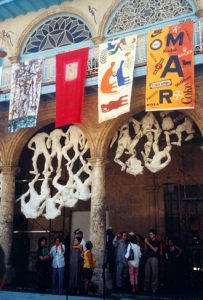
Havana Biennial. Inauguration on the Plaza Vieja, 2000.
Rather than being a plot, what in fact we are dealing with here is a trend. At a time of “world” movements and planetary NGOs, everyone is looking toward far-off horizons against the background of a mental abolition of borders. As a consequence, the tendency is to disqualify polar opposites. By this measure, knowing that immobility works against the present-day consensus about the circulation of ideas (as well as of artists, of cultural officials, and so on), a biennial that wishes to be legitimate will picture itself as a biennial from elsewhere, one that is “exotic,” or, better still, migratory, perpetually changing in space, and boasting a fitting list of artists. For the past fifteen years, the recurrent notions on which biennials have relied are, unsurprisingly, those of geographical provenance, cultural identity, exchange, and genuine litanies.
The existence of a biennial–and the art that would come out of it with increased stature because of the media attention it garners–has to do only in part with art properly speaking. For, every biennial is a sign before it is a content. With joint financing from Spain and Argentina, the Havana Biennial is also taken as a factor in the establishment of good relations within the Spanish-speaking world. As it exited from apartheid, and anxious to open up to the world, South Africa intentionally created the Johannesburg Biennial in 1995–though at the risk of becoming dependent upon the outside world, in its case. Coopted, in effect, by the West and then, during its second and final edition in 1997, by the ideologues of “creoleness,” it ultimately turned its back on local artists’ hopes for visibility, dispossessing them and disappointing them.
Are culture and, within the world of culture, biennials, something like the continuation of politics by other means? Most certainly so. And yet in a comforting reminder, we hear the following ecumenical argument from the artist David Medalla–the creator, in 2000, of his own London biennial–“When all is said and done, it is preferable that exchanges between peoples take place via biennials rather than through wars.”[ref]Translator: This is a translation back into English of Ardenne’s translation from memory into French.[/ref]
Bibliography
Exhibition Catalogues:
Primitivism in the Art of the 20th Century. Museum of Modern Art, New York, 1984.
Magiciens de la Terre. Georges Pompidou Center, Paris 1989.
Partage d’exotismes. Fifth Biennial of Contemporary Art, Lyon, 2000.
Documenta 11. Kassel, 2002.
Books and Articles:
Homi K. Bhabba. “Beyond the Pale: Art in the Age of Multicultural Translation.” In Elisabeth Sussman, Thelma Golden, John G. Hanhardt, and Lisa Phillips, eds. 1993 Biennial Exhibition, pp. 62-73. New York: Whitney Museum of American Art in association with Harry N. Abrams Inc., 1993.
Anna Maria Guasch. El Arte del Siglo XX en Su Exposiciones. Barcelona: Ediciones del Serbal, 1997. See, in particular, pp. 402ff.
Thomas McEvilley. Art and Otherness: Crisis in Cultural Identity. Kingston, New York: Documentext, 1992.
Nikos Papastergiadis. “An Introduction into the Aesthetics of Deterritorialisation.” In Art and Cultural Difference, Art Design, 43 (August 1995): 6-8.
Paul Ardenne, who has a teaching certificate in History and a PhD in Art History, is an associate professor at the Faculty of Arts in Amiens. He has collaborated with the French review Art Press since 1990, along with several other French and foreign publications, including: Figures de l’art, Archistorm, L’Art même, Esse, and Inter. Ardenne has published several works on museography (Capc-Musée 1973-1993), creative artistic work today (La création contemporaine entre structures et système as well as Art, l’âge contemporain) and, more broadly, present-day culture (1989). Among his recent works, one can cite L’Art dans son moment politique (2001), L’Image Corps (2001), a study devoted to figures of the human being in twentieth-century art, Un Art contextuel (2002), an essay on modern and contemporary artistic forms of political engagement and radicalism, and Portraiturés, a work devoted to photographic portraiture. Ardenne has also authored various monographs on architects (Christian Hauvette, Rudy Ricciotti, Alain Sarfati, Manuelle Gautrand, Philippe Gazeau, etc.), a compendium narrative of voyages Terre habitée–Humain et urbain à l’ère de la mondialisation (2005), and, finally, a novel, La Halte (2003). His latest book, Extrême–Esthétiques de la limite dépassée, is forthcoming from the Flammarion Press in October 2006.
